Planets
Jupiter rotating - Oct. 20, 2021
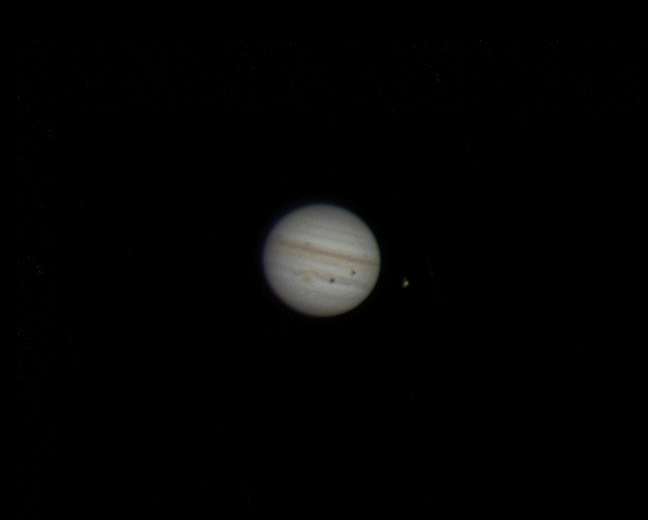
This is a six frame Jupiter animation from 10:18 to 10:33 Wednesday evening.
The Great Red Spot is lower center.
It is smaller and fainter compared to years ago.
Callisto is the dark spot just to the right of the GRS.
Above and to the right of Callisto is the shadow of Io.
Io itself is moving away from the planet to the right.
The seeing was pretty bad tonight, but I decided to try anyway.
It has been a couple of years since I had tried any planetary imaging.
I kept to my C-8's native focal length of 2000mm because of the poor seeing.
I captured six different 60 second long AVI videos and selected the best 20% of each
to stack.
Details:
Location: Front yard Cary, NC
Camera: ASI120MC-S
Exposures: 6 groups of the best 20% of approx. 3000 10ms long AVI frames
Filter: none
Scope: Celestron Edge HD-800 at f/10
Mount: iOptron GEM-45
Guider: none
Capture software: Firecapture 2.6
Guiding software: none
Calibration frames: none
Processing software: Autostakkert 3, Photoshop, and GIF Animator
Back to Mark's Astrophotography Home
Mars - August 6, 2018
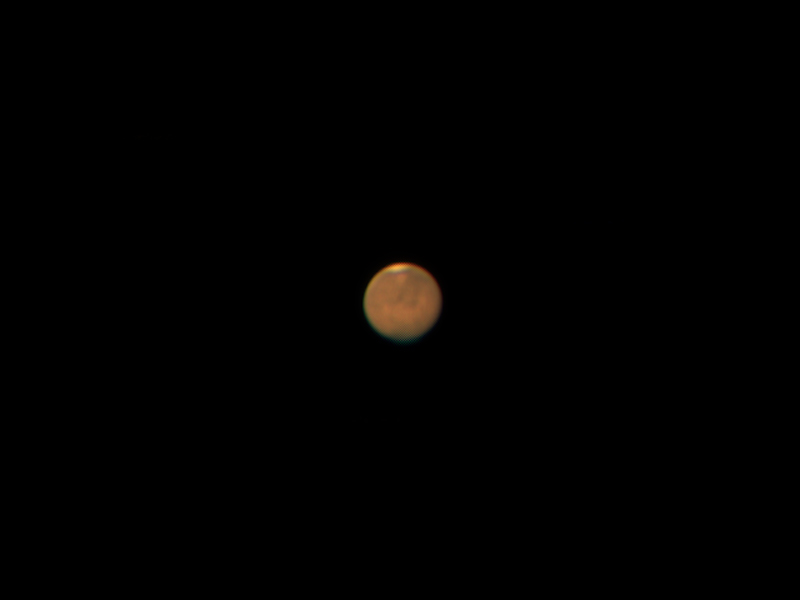
Mars on August 6 at around midnight.
This is my first Mars attempt in about two months.
The dust storms seem to be subsiding somewhat now,
but one is prominent near the south polar cap at the top.
The central meridian at the time of the photo was 40 degrees.
This image was captured with an ASI 120mc-s camera and a Celestron HD 800 SCT at f/10.
The scope was mounted on a Celestron AVx mount.
1540 of 5136 frames over 90 seconds (57 fps)
were staked together using Autostakkert 2. An ROI of 640 x 480 was used.
The image was enlarged by 25% in Photoshop.
Seeing was only fair tonight.
Back to the top of the page
Back to Mark's Astrophotography Home
Saturn - June 30, 2018
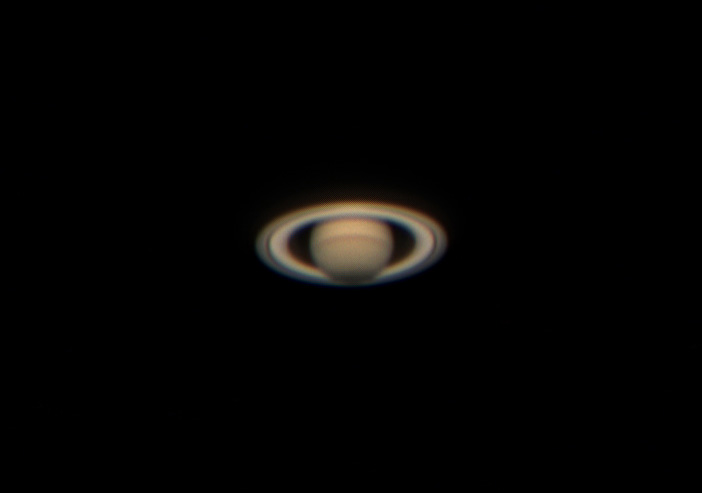
Saturn near opposition 2018.
This image of Saturn was captured around 12:25 am from my front yard in Cary, NC.
South is at the top.
It is a composite of the best 192 frames of 640 captured over 3 minutes.
High clouds were present.
The image was captured with my Celestron Edge HD 800 SCT on an AVx mount.
I was using a Televue 1.8x barlow in front of an ASI 120mc-s camera.
Exposure times were only 3 frames per second.
The images were processed in Autostakkert and sharpened with Registax.
Seeing was only fair - about 3 out of 5.
Back to the top of the page
Back to Mark's Astrophotography Home
Jupiter with Red Spot - June 17, 2018
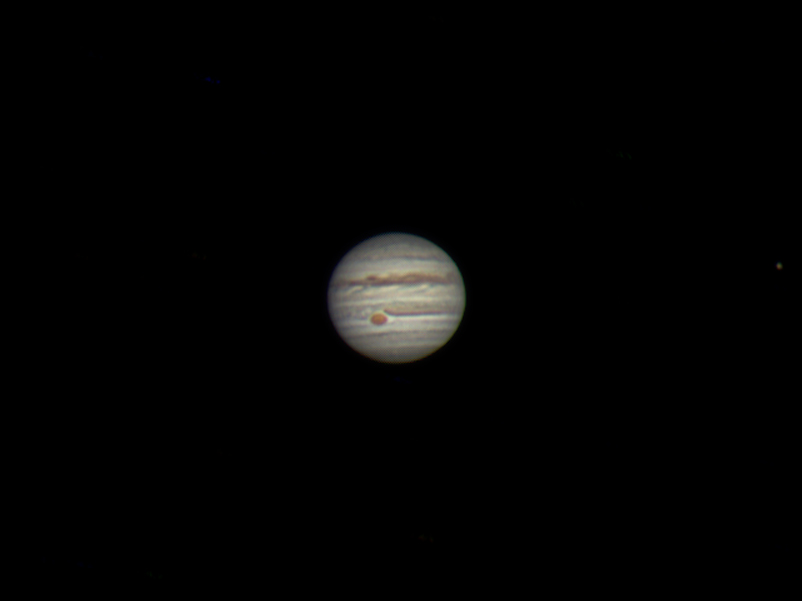
Jupiter with Red Spot. I have been trying for several years to get a decent
shot of Jupiter with the red spot visible.
This one isn't great, but it is the best so far.
The image above was taken at 11:58 pm from my fron yard. The seeing was only fair.
It was quite warm and humid.
This image was shot straight through my Celestron Edge HD 800 at f/10 on my AVx mount.
I was using my ZWO ASI120MC-S color camera and Firecapture to capture the images.
Autostakkert was used to stack the images.
The stacked image above was made from the best 20% of 2000 frames.
I was using a shutter speed of 30 ms at gain 25 and a ROI of 800 x 600.
Photoshop was used to enlarge the image 25% before cropping.
Back to the top of the page
Back to Mark's Astrophotography Home
First Mars of the season - June 10, 2018
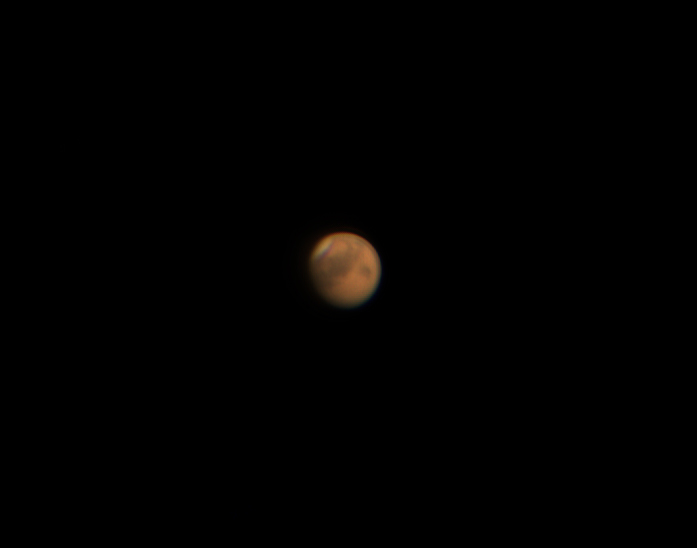
Mars at 4:49 am on June 10. The south polar ice cap is at the upper left.
Syrtis Major is right of center and it appears to be cut in half by an equatorial
dust storm.
This image was captured with an ASI 120mc-s camera, a Celestron HD 800 SCT,
and a Televue 1.8 barlow for an effective focal length of 3600 mm.
The scope was mounted on a Celestron AVx mount.
About 1200 frames were captured in 30 seconds and the best 30% of those
were staked together using Autostakkert 2. An ROI of 800 x 640 was used.
The temperature at time of capture was about 70 degrees and it was humid.
There were high clouds over Mars at capture time.
The seeing was only fair.
Back to the top of the page
Back to Mark's Astrophotography Home
Jupiter with Io at left - May 26, 2018
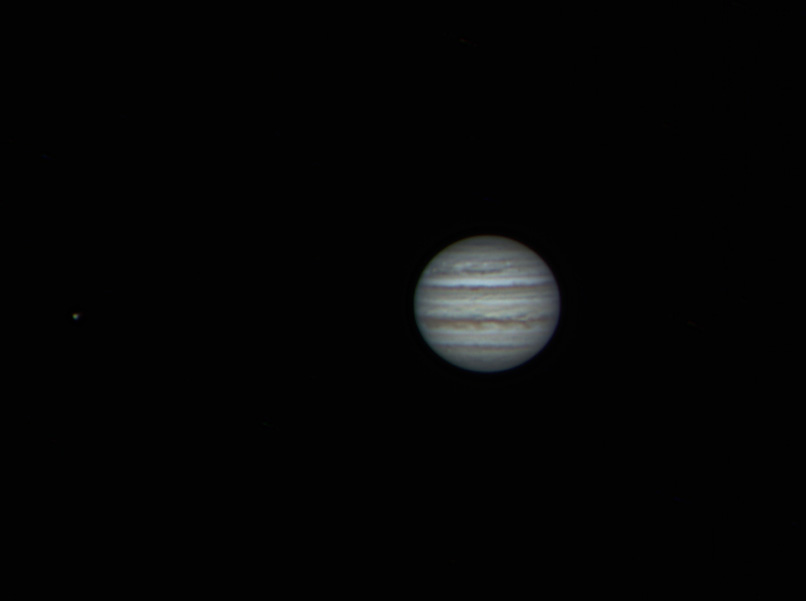
After waiting about an hour at the telescope and experiencing bad seeing yet again,
the seeing finally settled enough to get a decent set of images of Jupiter.
In the span of 10 minutes around 12:30 am, conditions really improved.
The image above was taken at 12:43 am.
Tonight, I decided to try my luck without using any barlow lens.
This image was shot straight through my Celestron Edge HD 800 at f/10 on my AVx mount.
I was using my ZWO ASI120MC-S color camera and Firecapture to capture the images.
Autostakkert was used to stack the images.
The stacked image above was made from the best 30% of 2659 frames.
I was using a shutter speed of 18.4 ms at gain 25 and a ROI of 800 x 600.
Photoshop was used to enlarge the image 25% before cropping.
The images were taken from my front yard in Cary.
Click on the single image above to see a 5 frame animation in a new window.
Back to the top of the page
Back to Mark's Astrophotography Home
Io and shadow moving off Jupiter - May 23, 2018
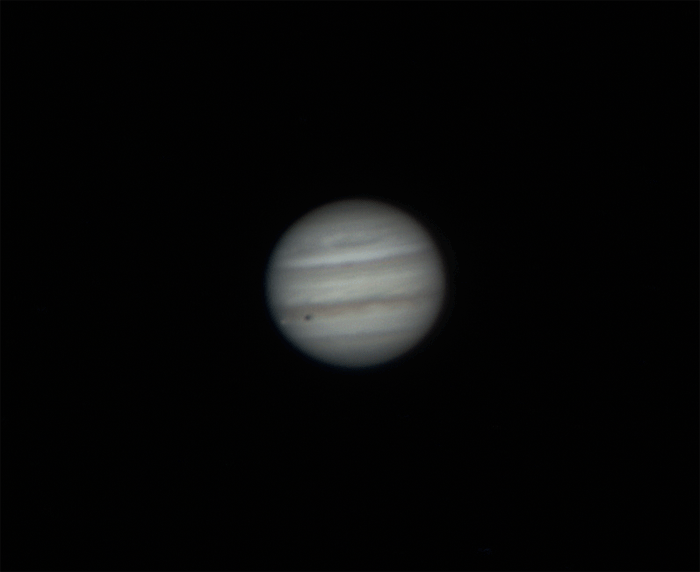
This is a six image gif of Jupiter taken on May 23, 2018 from 10:54 to 11:07 pm
as Io and it's shadow were leaving Jupiter.
High clouds and bad seeing made the images a bit blurry and finally shut me down by 11:15.
The images were shot straight through my Celestron Edge HD 800 and a 1.8x Televue barlow
which gives a mirror image. The telescope was mounted on my Celestron AVx.
I was using my ZWO ASI120MC-S color camera and Firecapture to capture the images.
Roughly the best 330 images from 6 different sets of images were stacked with AutoStakkert and then
made into a gif animation using Photoshop.
Each individual image was a bit over 50 ms long.
The images were taken from my front yard in Cary.
Back to the top of the page
Back to Mark's Astrophotography Home
Saturn at opposition - June 16, 2017

This image of Saturn was captured just before 2 am this morning through high clouds.
It was just about to transit at a low altitude of 31 degrees above the southern horizon.
Opposition had occurred earlier in the day.
The seeing was pretty good tonight but not great.
It was better than on my previous two attempts about a week ago which yielded much blurrier images.
In addition to the seeing problems due to low altitude,
there was occasional heat lightning and high clouds were present.
Despite all of this the views were pretty good both for the camera and through the eyepiece.
This image was taken through my Celestron Edge HD 800 (C-8) using a TeleVue 1.8x barlow
to give a focal length of 3657 mm and a f-ratio of 18.
I was using my Celestron Advanced Vx mount to track - no guiding.
An ASI120MC-S camera was used to capture 563 video frames at 3 frames per second.
Autostakkert was used to select the best 419 of those frames and stack them
into the final image. RegiStax was used to sharpen the image.
Back to Mark's Astrophotography Home
Jupiter with two moon shadows - May 19, 2017
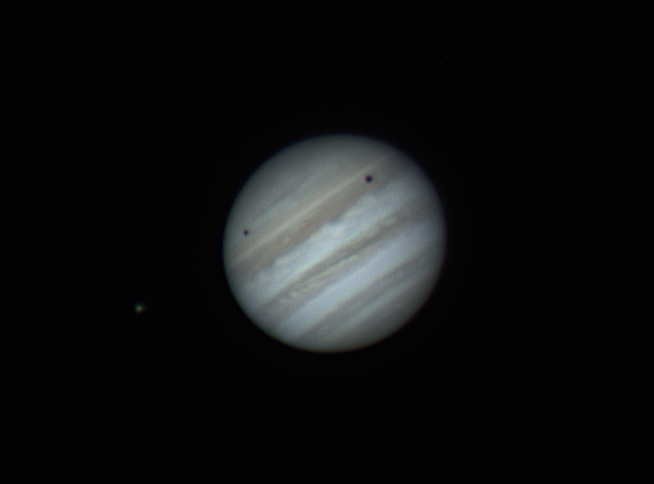
This image shows Jupiter at around 12:15am on Friday morning May 19.
At left, off Jupiter's disk is Europa.
On the upper left side of the planet is the shadow of Europa.
Towards the right side of the image inside the North Equatorial Band (NEB) is the shadow of Io.
Io itself is visible very near the center of the NEB, but it's color is nearly the same as
the band making it difficult to see.
The image is mirror reversed because I was using a diagonal mirror on the telescope.
This image was captured at my home in Cary using my Celestron Edge HD 800
mounted on an Advanced Vx equatorial mount.
I was using a Televue 1.8x barlow to enlarge the image.
The camera used was my new (to me) ZWO ASI120MC-S camera.
A one minute video file of 1530 frames at 30 frames per second was captured using Firecapture.
I used AutoStakkert 2.6.8 to select the best 370 frames of the video and create a stack for a tiff file.
The tiff file was taken into Registax 6 for wavelet sharpening to produce the final image.
The image was cropped in Photoshop CS2 and a jpg copy of the image was produced.
Back to Mark's Astrophotography Home
Pluto - July 10, 2015
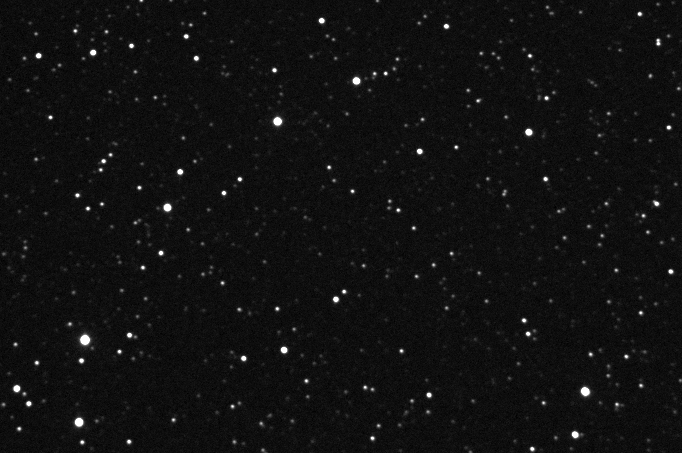
Friday night July 10, 2015 was a Raleigh Astronomy Club observing session at our Bigwoods site.
The evening temperatures started near 90 degrees with dew points in the low to mid 70s, making the night very uncomfortable.
Every once in a while, we would get a very subtle westerly breeze which helped a lot.
The seeing started out pretty good, but got worse as the night went on.
Since Pluto has been in the news lately because of the New Horizons fly-by,
I decided to try another animation but this time with my 8" f/6.2 home-made Newtonian reflector and my SBIG ST-402 CCD camera.
I had previously created animations with my 4" refractor over a two day period.
Pluto at magnitude 14.1 is currently located in a very crowded star field in Sagittarius.
After spending about 20 minutes finding and verifying the field which contained Pluto with my camera,
I started taking five sets of images separated by about half an hour. Exposures were tracked, but unguided.
The first group started around 11:30pm and I finished up around 1:30am.
You can notice the seeing get worse as the animation gets to frames 3-5.
Individual exposures were 15 seconds long and then dark subtracted.
The individual exposures were median combined with the best 7-10 frames in it's group and saved.
The photos were then taken into Photoshop and the animation was created.
Some star reduction and sharpening was used on the final three frames to compensate for the bad seeing.
Back to Mark's Astrophotography Home
Saturn - June 5, 2015
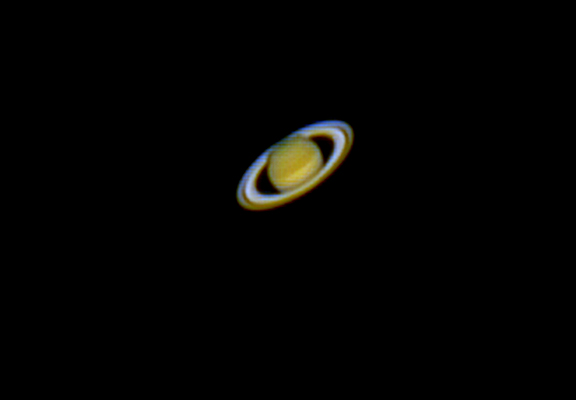
Saturn on June 5, 2015 around 11:45 taken from my driveway with my 8" f/6.25 homemade Newtonian reflector and a 2.5x barlow in front of my Phillips SPC 900NC webcam. The frames were captured with FireCapture and then processed in Registax 6. The best 200 frames were used. I did a little levels and enlargement with Photoshop CS2.
Back to the top of the pageBack to Mark's Astrophotography Home
Jupiter and IO

August 22, 2008 - Jupiter an Io. Here is the result of a video sequence I shot last night after the RAC meeting around 11:45 pm. I was in my front yard at home in Cary. The seeing wasn't that good and high clouds kept moving through, but I was aware that there should be a shadow in transit at a decent hour so I decided to give the imaging a shot. The black spot on the right side is the shadow of Io and that is Io itself just to the right of Jupiter. I used my Phillips wecam and my Celestron C-11 working at 2800mm at f/10 to get the video. I used the best 314 frames of the video and processed it in Registax. I used Photoshop to enlarge the image a bit for display.
Back to the top of the pageBack to Mark's Astrophotography Home
Jupiter & two shadows
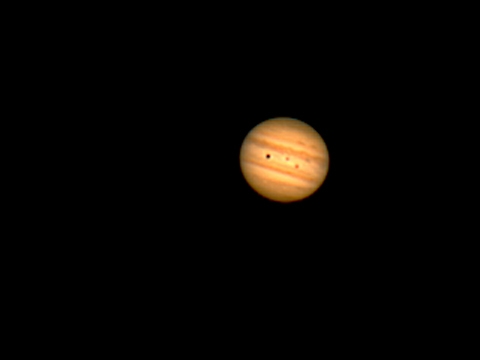
This is Jupiter on 8/26/09 at around 11:50 pm. From left to right are the shadows of Europa and Ganymede, then Europa and Ganymede themselves. Ganymede is very difficult to see. Captured with K3CCD Tools, register and stacking with Registax 4, and some final touch ups in Photoshop.
Back to the top of the pageBack to Mark's Astrophotography Home
Saturn
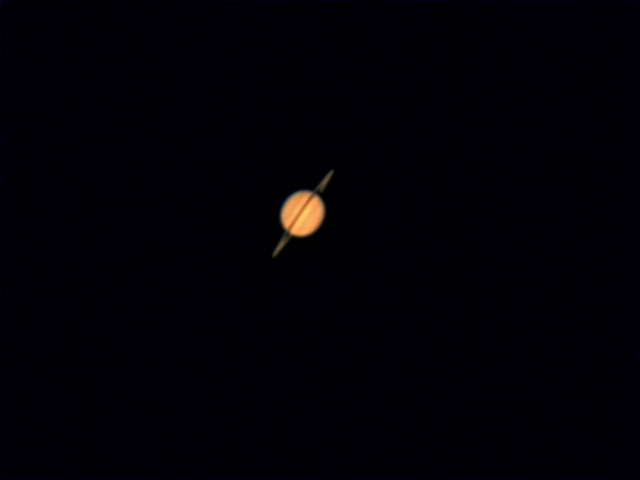
Saturn with its rings nearly edge on Apr. 26, 2009. This is my first ever attempt at imaging Saturn. I was using the C-11 and my Phillips Web Camera. The seeing was bad and the colors turned out a bit yellow/brown. I will try and address those issues next time. I was shooting 10 frames per second. I used Registax to align and combine the best 100 frames. We had some really nice weather today for NC. The temperatures made it up to 90 with low humidity during the day, so the night was very plesent. These images were made from my front yard in Cary, NC.
Back to the top of the pageBack to Mark's Astrophotography Home
Mars

Dec. 20, 2007 - This is my first image of Mars using the new Phillips web cam. It was taken at 12:10 am. The webcam was mounted prime focus on the Celestron C-11 which is a 2800mm f/10 scope.
Back to the top of the pageBack to Mark's Astrophotography Home